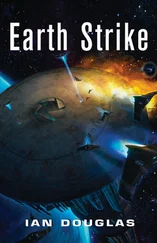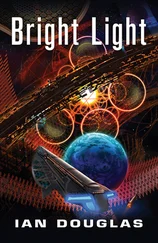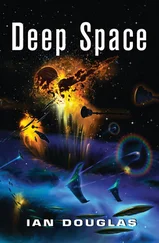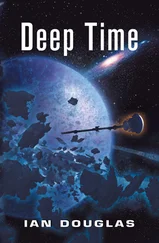“You haven’t heard from your clone on the America yet …”
“No. If our calculations are correct, they have only just arrived at the N’gai Cloud … if, indeed, the two different time frames can be meaningfully compared. But we have heard from the Agletsch. They have made available some information. Gratis .”
“They gave it to us?” Koenig was impressed. “That means it’s either worthless … or of unbelievably high value.”
“Agreed.”
The Agletsch exchanged information from across a vast swath of the galaxy for other information, as well as for certain rare elements—notably isotopes of neptunium and californium. They never gave stuff away for free.
Not unless it very definitely benefited them as well.
“So what’s the information?”
Koenig waited out the slight time delay. It took one and a quarter seconds for his words to reach Konstantin on Luna’s far side, another second and a quarter for the answer to return. Every exchange had a built-in 2.5-second pause.
“They strongly suggest that we check out Tabby’s Star,” Konstantin told him.
“I don’t know that one,” Koenig said. “At least not by that name.”
“Here is the download.”
Information flooded through Koenig’s implants and into his conscious awareness.
A mental window opened, filling with scrolling text.
Object:KIC 8462852
Alternate names:WTF Star, Tabby’s Star
Type:Main-sequence star; Spectral Type:F3 V/IV
Coordinates:RA: 20h 06m 15.457s Dec: + 44° 27′ 24.61″
Constellation:Cygnus
Mass:~ 1.43 SOL; Radius:1.58 SOL;
Rotation:0.8797 DAYS
Temperature:6750° K; Luminosity:5 SOL
Apparent Magnitude:11.7;
Absolute Magnitude:3.08
Distance:1480 LY
Age:~ 4 billion years
Notes:First noted in 2009–2015 as a part of the data collected by the Kepler space telescope. An extremely unusual pattern of light fluctuations proved difficult to explain as a natural phenomenon, and raised the possibility that intermittent dips in the star’s light output were the result of occultations by intelligently designed alien megastructures.
KIC 8462852 received the unofficial name “Tabby’s Star” after Tabetha S. Boyajian, head of the citizen scientist group that first called attention to the object. It was also called the “WTF star”—a humorous name drawn from the title of her paper: “Where’s the Flux?” At that time, “WTF” was a slang expression of surprise or disbelief.
The Tabby’s Star anomalies were eventually explained as a combination of an accretion disk and odd stellar geometry brought on by the star’s high rate of spin and resultant gravitational darkening …
There was a lot more information in the download, and Koenig waded through it. He wasn’t familiar with much of it.
In the early twenty-first century, the Kepler space telescope had continuously monitored the light coming from some 150,000 stars in a small section of Cygnus; planets orbiting those stars would periodically block a tiny percentage of the light, causing dips in the stars’ brightness.
That period, from 2009 through 2015, was a heady one of exploration and discovery, as thousands of exoplanets, worlds outside of Sol’s domain, were found, and Humankind became aware of the fact that the Milky Way alone might contain 40 billion worlds like Earth. Out of all of those target stars, however, only one had showed a light curve as bizarre as one sun at the very edge of the target area: KIC 8462852. Light dips were frequent, sharp, and aperiodic—behaving like large numbers of huge objects orbiting their star “in tight formation,” as one astronomer put it. One particular object did seem to have a regular period. The first time it was spotted, it obscured 15 percent of the star’s light. The second time, 750 days later, it obscured 22 percent of the light.
Twenty-two percent? A super-Jupiter, the largest world possible, typically obscured about 1 percent of the light from its star as it passed in front of the star’s disk. To cause that big of a drop in the light output of the star, the eclipsing object would have to be so large it covered nearly a quarter of the star’s face. This could not be a planet, so what the hell was it?
Dozens of theories were fielded—possible natural explanations, including huge dust clouds, masses of perturbed comets, and colliding planets. None worked very well. The system was too old to have dust clouds or accretion disks, the chances of finding it just when planets had collided or comets descended were nil, and the amount of detectable infrared radiation was a bad fit for all of those possibilities.
Increasingly, astronomers were forced to consider the unthinkable—that the odd light curve of KIC 8462852 was due to some sort of alien megastructure, an intelligently designed and built structure or series of structures, such as a Dyson sphere under construction or, more likely, a Dyson swarm—thousands of objects absorbing energy from the star. The light curves seemed to suggest solid-edged, irregularly shaped structures with distinct boundaries rather than diffuse clouds of dust.
But the alien megastructure idea had to be the very last possibility to be considered. That was not because the astronomers didn’t want to think about aliens, but because the alien hypothesis was not falsifiable by scientific testing … and so it could not be considered until every other possibility had been tested and ruled out.
And eventually, a natural explanation was found. Fast-spinning stars could suffer an effect called gravitational darkening while flattening from a sphere into an oblate spheroid; several large planets transiting across different parts of the star’s surface, plus an accretion disk of dust, could cause greater or lesser dips in the light curve.
There were problems with that theory, though. The star did spin quickly—at the equator it rotated once in 21 hours and a few minutes as opposed to 25 days for Sol—but not fast enough to cause severe distortion of the sphere. And, again, the star just wasn’t young enough to have an orbiting cloud or accretion disk of dust.
But by that time, the twenty-first century had been in free fall toward utter chaos. Stunning and widespread political corruption, quickly rising sea levels, economic collapse, global war with Islam, the First Sino-Western War, and the ravages of the Blood Death … it was a wonder, frankly, that Humankind had survived. The hanging of the first space elevator, in the twenty-second century, had helped reverse the collapse, bringing in the raw materials, cheap energy, and improved technologies that ultimately transformed the planet.
But as Humankind began to establish a firm foothold in the solar system, the excitement over KIC 8462852 was largely forgotten. It became an interesting anomaly, quickly explained and as quickly filed away and ignored.
“Okay,” Koenig said after several minutes reviewing the material. “An interesting observation, but it says here they explained it. Why are the Agletsch interested in the thing? Or, maybe I should say … why do they want us to be interested?”
“They did not discuss that,” Konstantin replied. “But they seem to believe that our explanation was wrong. That Tabby’s Star is in fact the location of an advanced alien civilization.”
“But not an ally of the Sh’daar, I take it.”
“Correct.”
Humankind now understood that the Sh’daar were interlopers from the remote past, from T- 0.876gy… a term usually abbreviated as “Tee-sub-minus,” or, in other words, from 876 million years in the past. They appeared to have recruited a number of alien civilizations in T prime(meaning time now , the twenty-fifth century): the Turusch, the H’rulka, the Nungiirtok, the Slan, and quite a few others. That alliance, called the Sh’daar Collective, had been deployed against Humankind in an effort to force them to give up tech-singularity-inducing technologies. The Collective apparently extended into the future as well; the Glothr, from a rogue planet millions of years in the future, might well have been working with the Sh’daar, though the nature of that relationship was still uncertain.
Читать дальше












